35 lat temu 27 września 1985 roku w kierunku stacji orbitalnej Salut-7 wystartował jako ostatni bezzałogowy statek kosmiczny pod nazwą Kosmos 1986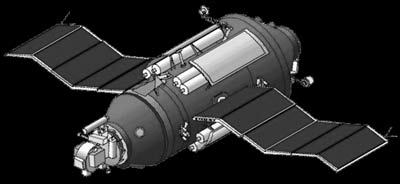 Космос-1686http://www.russianspaceweb.com/tks.html25 лет со дня запуска секретного космического корабля ТКС под именем "Космос-1686"
Космос-1686http://www.russianspaceweb.com/tks.html25 лет со дня запуска секретного космического корабля ТКС под именем "Космос-1686"27 сентября 2010, 23:02
27 сентября 1985 года в 11 часов 41 минуту московского времени с космодрома Байконур ракетой "Протон" был запущен последний из серии тяжелый транспортный корабль снабжения ТКС, который затем под именем "Космос-1686" состыковался со станцией "Салют-7".
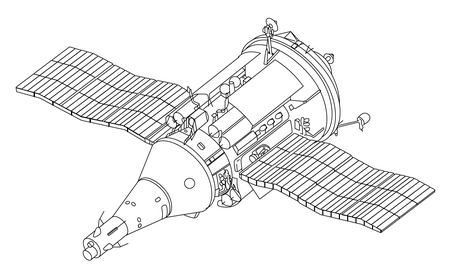 Космос-1686. Рис из Википедии
Космос-1686. Рис из Википедии11 февраля 1985 года находящаяся в автономном (без экипажа) полете станция в результате неисправности оборудования была полностью обесточена, потеряла ориентацию в пространстве и связь с Землей.
Для спасения станции на специально переоборудованном космическом корабле "Союз Т-13" 6 июня была отправлена экспедиция в составе Владимира Джанибекова (командир) и Виктора Савиных.
На тот момент Джанибеков, совершающий свой пятый полет, был самым опытным советским космонавтом. К тому же он имел опыт ручной стыковки.
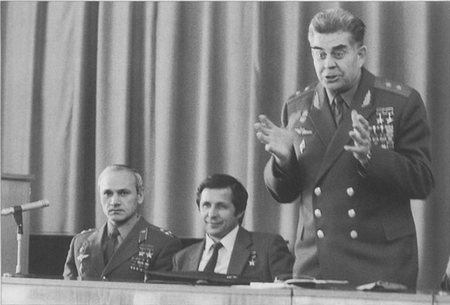 Г.Т.Береговой представляет экипаж: В.Джанибеков и В.Савиных. Фото из книги Виктора Савиных «Вятка-Байконур-космос»
Г.Т.Береговой представляет экипаж: В.Джанибеков и В.Савиных. Фото из книги Виктора Савиных «Вятка-Байконур-космос»Вместо демонтированного третьего кресла взяли дополнительный запас воды, что, по мнению Виктора Савиных, и позволило в принципе осуществить программу полета.
После стыковки в ручном режиме была выявлена и устранена неисправность в системе контроля электропитания станции, из-за которой, вследствие отключения всех бортовых систем, температура "в помещении" упала ниже нуля градусов. После ликвидации неисправности работоспособность "Салюта-7" была полностью восстановлена.
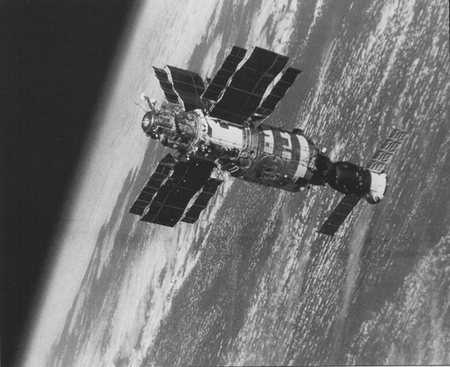 Салют-7 и Союз. Фото из книги Виктора Савиных «Вятка-Байконур-космос»
Салют-7 и Союз. Фото из книги Виктора Савиных «Вятка-Байконур-космос»Затем 20 сентября на станцию на корабле "Союз Т-14" прилетела экспедиция в составе Владимира Васютина, Александра Волкова и Георгия Гречко. Джанибеков и Гречко вскоре, 26 сентября, вернулись на Землю.
Транспортный корабль снабжения состыковался со станцией 2 октября 1985 года и доставил на нее 4322 кг расходных материалов и оборудование более 80 наименований. В баках ТКС находилось 1550 кг топлива для поддержания орбиты станции.
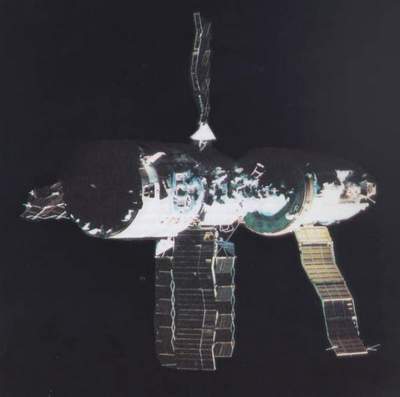 Салют-7 и Космос-1686. Фото с форума журнала Новости космонавтики
Салют-7 и Космос-1686. Фото с форума журнала Новости космонавтикиГлавным же на корабле было научное и "специальное" оборудование массой 1255 кг. Аппаратура предназначалась для проведения более 200 экспериментов.
Военно-прикладной оптический комплекс "Пион-К" с лазерно-электронным телескопом предназначался для оптического наблюдения (разведки) с высоким разрешением, а также для выполнения программы "Октант" в интересах системы контроля космического пространства и ПРО. Объектами наблюдения "Пиона-К" должны были стать специальные цели, отделяемые из пусковых устройств, закрепленных снаружи, а также реальные цели на Земле, поверхности океана и в атмосфере.
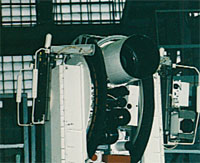 Пион-К. Фото с сайта arms-expo.ru
Пион-К. Фото с сайта arms-expo.ruПо словам Савиных, военные космонавты Васютин и Волков целыми днями не вылезали из ТКС, проводя эксперименты с этим комплексом.
Первоначально корабль был создан для обслуживания военных станций типа "Алмаз" разработки КБ Владимира Челомея. В том же конструкторском бюро, где была создана ракета-носитель тяжелого класса "Протон", возможности которой и определили массу аппарата - 20 тонн, как у станций "Салют" и "Алмаз", выводимых на орбиту тоже этой ракетой.
Благодаря своим размерам ТКС имел возможность транспортировать не только трех космонавтов, но и большое количество топлива и грузов, а затем возвращать на Землю в многоразовом спускаемом аппарате экипаж и возвращаемые материалы (в том числе отснятую широкоформатную пленку).
Корабль же "Союз", который уже использовался для этих целей, в силу размерности, определяемой возможностями своего носителя, ракеты "Союз", мог доставить на станцию вместе с космонавтами лишь минимальное количество грузов, а вернуть - буквально считанные килограммы.
К сожалению, ТКС не совершил ни одного пилотируемого полета по той же причине, по которой советские космонавты не совершили облета Луны - ракета "Протон", которая была носителем в обеих случаях, заправлялась высокотоксичным топливом, что создавало опасность гибели экипажа в случае аварии на старте.
Ответственность же за возможную катастрофу на себя брать, естественно, не хотел никто.
Кстати, одним из первоначальных вариантов создания станции "Мир", как пишет в своей книге космонавт Аксёнов, была схема со стыковкой служебных модулей (типа ТКС) к базовому блоку. При этом модули могли отстыковываться и переходить в автономный полет для выполнения экспериментов, а их возвращаемый аппарат использоваться еще и как средство спасения экипажа станции.
https://m.polit.ru/news/2010/09/27/tks_1686/